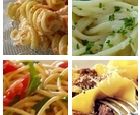|
Italian Entree A Table of Many Sauces Set a buffet table with a variety of sauces and bowls piled high with different types of pasta. Include a green salad, crusty Italian bread, and bowls of freshly grated Parmesan or Asiago cheese. Let your guests have at it! Tip: Toss the pasta with a little oil to keep it from clumping together. Pesto Sauce 5 cloves garlic (crushed, minced) In a food processor, pulse garlic and pine nuts with salt. Add cheeses, basil and pepper; blend thoroughly. Through the opening in the top, add oil, very gradually, in a thin stream, making sure it gets incorporated into basil-cheese mixture. Serve warm or at room temperature. Tuna Sauce 7-oz. can tuna with oil Drain tuna, reserving 1 T of its oil. Flake tuna meat and set aside. In a saucepan, heat tuna oil and olive oil till hot. Add garlic and sauté till brown. Remove and discard garlic. (You’re just flavoring the oil.) Add mushrooms, sautéing for 3-5 minutes, till soft. Add chopped tomatoes and vinegar, cover, and cook over low heat for 10 minutes. Add flaked tuna, salt & pepper, and stir in dried herbs. Cook for a few more minutes to warm tuna. Right before serving, stir in fresh chopped parsley. Zucchini, Tomatoes & Pine Nuts 1/2 lb. prosciutto (large dice) * In a saucepan, sauté prosciutto in melted butter (careful to burn). Add mushrooms and continue sautéing till mushroom liquid is reduced, about 7-8 minutes. Lower heat and add cream, stirring constantly, being careful not to boil. Add cheese and continue stirring. Serve immediately. * If you can’t find prosciutto, capicola works just as well. It’s also considerably cheaper than prosciutto. Sicilian Eggplant Relish 2 lbs. eggplant (peeled, 1” cubes) Eggplant: preheat oven to 350. Sprinkle eggplant cubes with salt and set in colander to drain for 30 minutes. Rinse and pat dry. In a large bowl, toss eggplant with 2 T oil, place on foil-lined baking sheet, cover with foil, and bake 15 minutes till glistening and tender (not mushy). Vegetables: heat remaining 2 T C oil in large skillet, add celery and onion, cooking 10 minutes till soft. Add eggplant mixture and cook, stirring, for another 2-3 minutes. Combine vinegar with sugar and pour into eggplant-onion mixture. Add remaining ingredients (except pine nuts). Final cook: bring to a boil and simmer, uncovered, for 15 minutes, stirring frequently. Remove from heat and add pine nuts. Refrigerate (relish keeps for a good week or more). Serve at room termperature over cold pasta, or warm over hot pasta. |
Tips & Glossary Arborio Rice: a medium-grained rice. Its high starch content yields a creamy texture and is the basis for risotto. Balsamic Vinegar: dark, thick vinegar with a sweet pungent flavor. Fermented, concentrated, and aged in wooden casks, sometimes up to 12 years. Can be pricey. Caper: salty, pickled bud of spiny shrub native to the Mediterranean region. Most prized is the non-pareil, the smallest (approx. 1/8”), though other sizes are tasty and less expensive. Formaggio: Cheese! Like France, Italy is a land of sublime cheeses, some 400 varieties. Here are some of the most widely sold in the U.S. Italian Seasoning: blend of dried herbs used in Italian cooking—marjoram, thyme, rosemary, savory, sage, oregano, and basil. Packaged commercially and found in most food stores. You can also make your own. Olive Oil: There's much more to know than is room for here. To learn all you need to know about the different grades of oil, and much, much more, head to Tanbourit. Pine Nuts: pinoli or pignoli; edible seeds of pine trees used in pesto sauce. Before cooking, release flavor by lightly browning in a heated skillet. Roasted peppers: buy or make your own: place under a broiler, or hold over a gas flame, till skin chars and blisters. Place in a closed paper bag for 15-20 minutes (to steam them). When cool, the skins slip off under water. Prosciutto: especially Prosciutto di Parma, dry-cured ham from Parma. The real deal! Cured up to 2 years, is almost sweet and very expensive. You can substitute with capicola, a delicious, light peppery ham.
|
Site by BOOM
![]()
LitLovers © 2024

